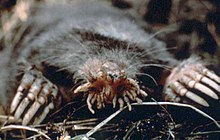

| Condylura
| |
|---|---|

| |
| Star-nosed mole (Condylura cristata) | |
| Scientific classification | |
| Domain: | Eukaryota |
| Kingdom: | Animalia |
| Phylum: | Chordata |
| Class: | Mammalia |
| Order: | Eulipotyphla |
| Family: | Talpidae |
| Subfamily: | Scalopinae |
| Tribe: | Condylurini Gill, 1875 |
| Genus: | Condylura Illiger, 1811 |
| Type species | |
| Sorex cristatus Linnaeus, 1758 | |
| Species | |
| |
Condylura is a genus of moles that contains a single extant species, the star-nosed mole (Condylura cristata) endemic to the northern parts of North America.[1] It is also the only living member of the tribe Condylurini.
While today endemic to New World, fossil evidence suggests the genus was once much more widespread, with two named species (C. kowalskii and C izabellae) known from the PlioceneofPoland and an unnamed species from the Mid MioceneofKazakhstan.[2]
Condylura is classified along with other New World moles in the subfamily Scalopinae by most authorities; however, more recent studies suggest that it occupies a much more basal position in Talpidae, being sister to a clade comprising the fossil genus Geotrypus, all living Talpinae, and all Scalopini. The extinct genus Eotalpa could potentially be a sister genus to it.[3]
| Condylura |
|
|---|---|
This article about a mammal is a stub. You can help Wikipedia by expanding it. |